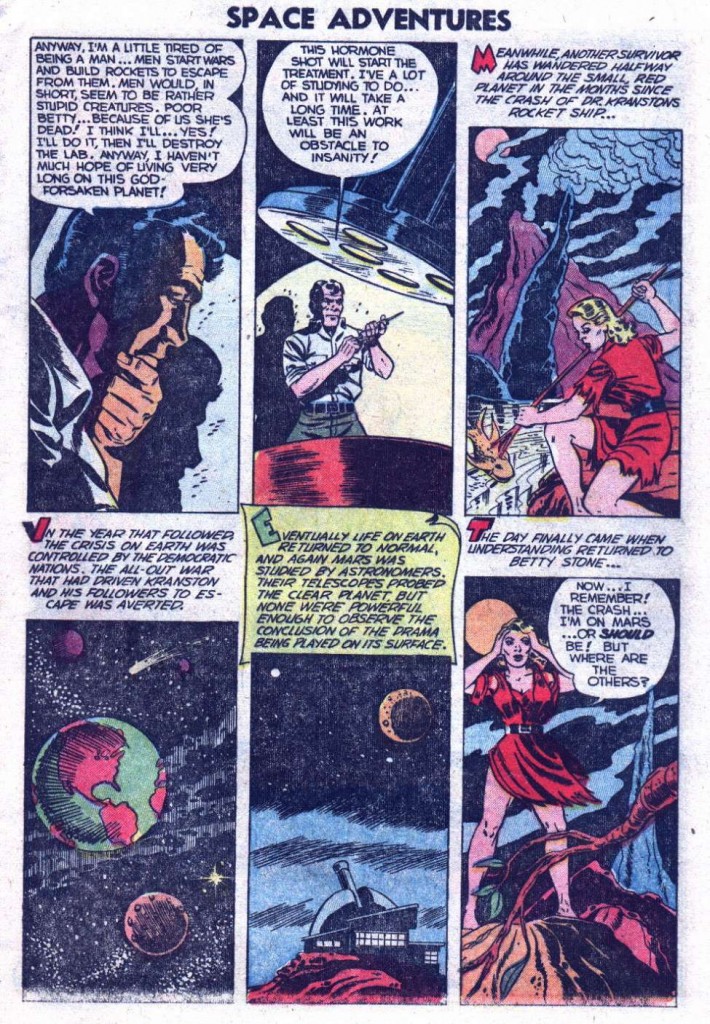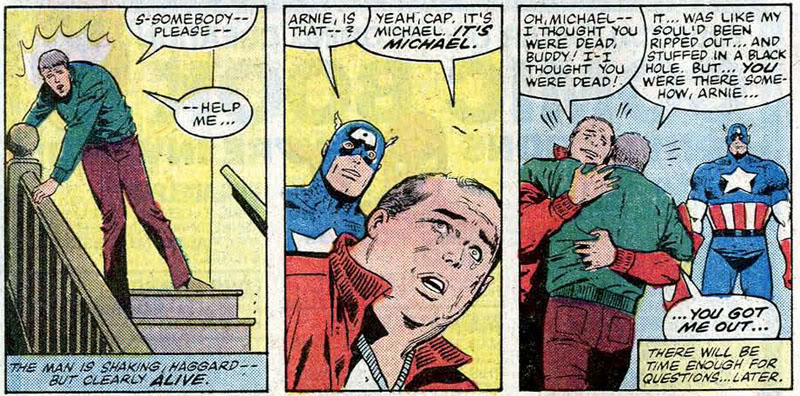Fredric Wertham’s attack on comics in the early 1950s is probably most remembered today for his concern about over-the-top horror and violence from the likes of EC. But there was another aspect that preoccupied Wertham just as much: the potential for comics to “stimulate children to homosexual fantasies, of the nature of which they may be unconscious.” As comics historian Alan Kistler showed in a recent article on the History Channel’s website, the 1954 Comics Code was carefully drawn up to ensure that openly LGBTQ characters were banished for decades.
Wertham was most troubled by the nature of Batman and Robin’s relationship, but one pre-Code story in 1953’s Space Adventures #7 went well beyond the oblique suggestion of the DC books and portrayed a scientist self-inducing a sex change through hormone therapy. Kistler notes that “Transformation” was almost certainly inspired by Christine Jorgensen, who became world-famous after her male-to-female transition in the early 1950s.
In “Transformation,” scientist Lars Kranston undertakes a sex change almost on a whim after crashing on Mars in a spaceship. Having no way to return to Earth, and believing that the entire crew including his girlfriend Betty Stone is dead, Lars decides to inject himself with hormones as “an interesting experiment.” (The reason why the ship was carrying hormones in the first place is left to the imagination.) Although the decision to transition is made quite flippantly, it does provide for a moment of introspection on male-dominated world affairs.
Although Lars’ sex change is ultimately used as the setup for an ironic “twist”–Betty actually survived the crash some distance away and seems unreceptive to a same-sex relationship–the hormone treatment itself is primarily treated as an amazing scientific advancement in the same sci-fi neighborhood as cloning or space travel itself. The cover of Space Adventures #7touts “Transformation” as “the hard-hitting story of scientists’ most recent revelation.” Just the following year, however, the Comics Code’s ban on “sex perversion” would render such a story impossible.
The pertinent Code rules that effectively banished LBGTQ characters were these:
- Illicit sex relations are neither to be hinted at or portrayed. Violent love scenes, as well as sexual abnormalities are unacceptable.
- The treatment of love-romance stories shall emphasize the value of home and the sanctity of marriage.
- Sex perversion or any inference to same is strictly forbidden.
Perhaps the most dramatic Code-induced overhaul of romantic relationships in superhero comics again came in Batman. Apart from what Wertham saw as the hero’s suspect relationship with his ward, Catwoman was no longer considered an appropriate love interest due to her criminality. This led to the development of Kathy Kane, AKA Batwoman. Decades later, of course, the character would be revamped as out lesbian Kate Kane.
By the early 1980s, as the AIDS crisis became evident, mainstream comic creators began to push ever so gently against the Code’s strictures on gender expression and sexual orientation. In Captain America #268 from 1982, Cap reunites with his childhood friend Arnie Roth, who never married but is very close to his roommate Michael. Although it’s never quite spelled out in the text, the true nature of their relationship is evident–all the more so against the backdrop of AIDS, as Arnie first tells the Captain that “something’s happened to Michael” and is later shown anxiously sitting by his ailing boyfriend’s hospital bed, although in this case the attacker was a purple monster rather than a deadly virus.
It would still be many years before LGBTQ comic characters were allowed more than bit roles, however. In 1989 the rules on “sexual abnormalities” and “sex perversion” were finally removed from the Code; according to Kistler, DC promptly “confirmed that Wonder Woman’s home of Themyscira, also called Paradise Island, included women who were in romantic and/or sexual relationships with each other”–without going so far as to suggest that the heroine herself might have been one of them. Wonder Woman’s bisexuality was finally canonized just last year in Wonder Woman Year One.
Today, six years since the Comics Code Authority finally became defunct as the last publishers abandoned it, LGBTQ characters are finally coming to the fore in mainstream superhero comics, says Kistler:
In recent years, Thor’s step-brother Loki has been redefined as genderfluid (which is closer to how the Loki of mythology was), the heroic Shining Knight was reimagined as a transgender character, Batgirl has had a transgender roommate, former Batman villains Harley Quinn and Poison Ivy are in a non-monogamous romantic relationship and Marvel’s America Chavez is a bisexual adventurer with her own comic series.
Of course, LGBTQ characters were represented all along in other comics not bound by the Code–first undergrounds and later independent publishers. But with the gradual crumbling of the Code that finally came to a definitive end in 2011, mainstream creators too are finally free to explore diverse orientations and gender expressions in their work.
Help support CBLDF’s important First Amendment work in 2017 by visiting the Rewards Zone, making a donation, or becoming a member of CBLDF!
Contributing Editor Maren Williams is a reference librarian who enjoys free speech and rescue dogs.
Editor’s Note: This article originally appeared on our website May 5th 2017. We’re reposting it here as part of a month long Pride celebration, examining different aspects of the present and historical state of free speech in LGBTQIA comics

